Analysis of Leadership and Management in Marks and Spencer
VerifiedAdded on 2020/10/22
|23
|6670
|454
Report
AI Summary
This report provides a comprehensive analysis of leadership and management practices within Marks & Spencer (M&S), a prominent multinational retail company. The report begins by differentiating between the roles of leaders and managers, highlighting their responsibilities and characteristics, and exploring Henry Mintzberg's managerial roles. It then delves into the functions of a manager according to Fayol, including planning, organizing, commanding, coordinating, and controlling, and how these functions are applied within M&S. The report also examines different approaches to operations management, focusing on the approach used by M&S, and the role of a store manager as an operations manager. Furthermore, it discusses the importance of operations management in achieving business objectives and the impact of external factors on operational management and decision-making processes within the company. Through this analysis, the report provides valuable insights into effective leadership and management strategies in the retail sector.
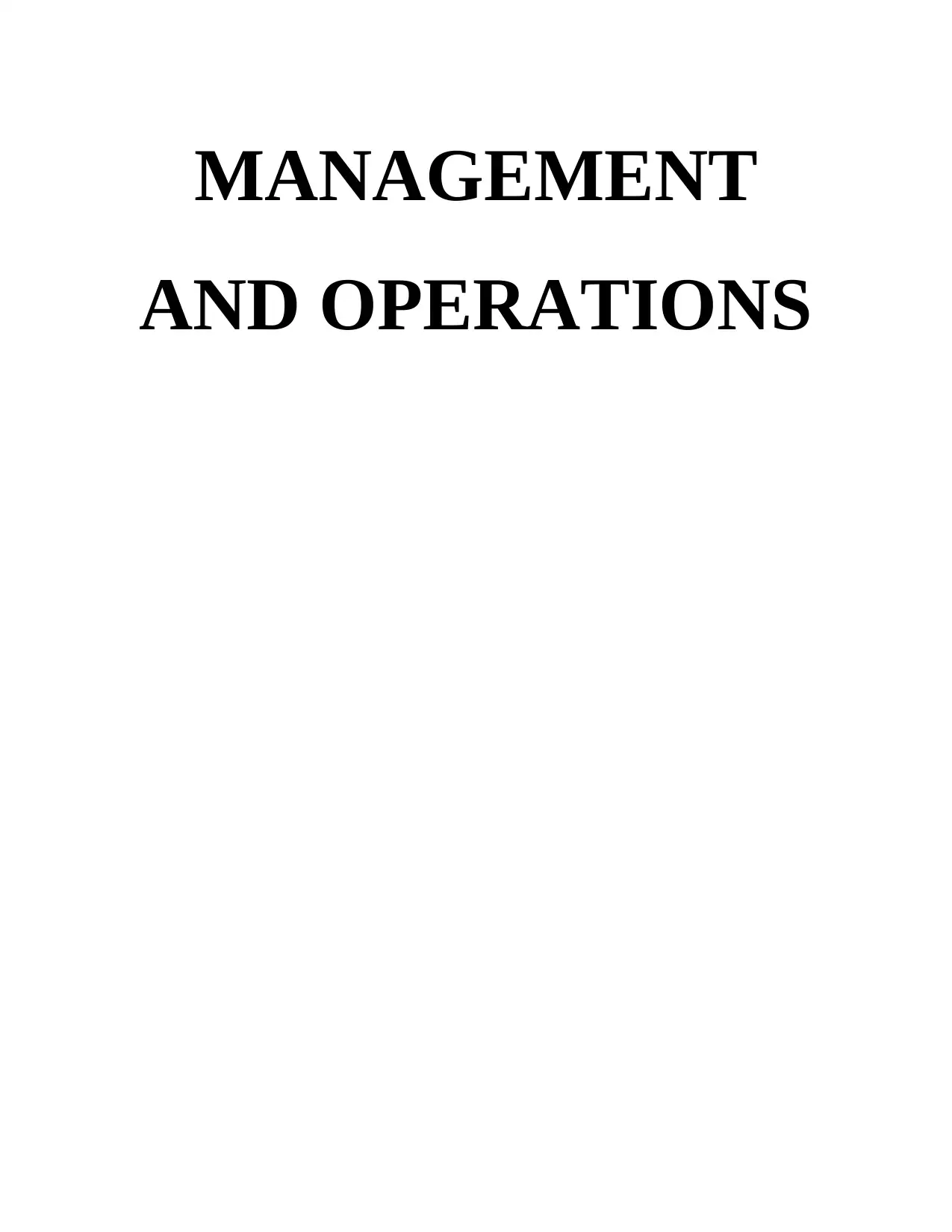
MANAGEMENT
AND OPERATIONS
AND OPERATIONS
Paraphrase This Document
Need a fresh take? Get an instant paraphrase of this document with our AI Paraphraser
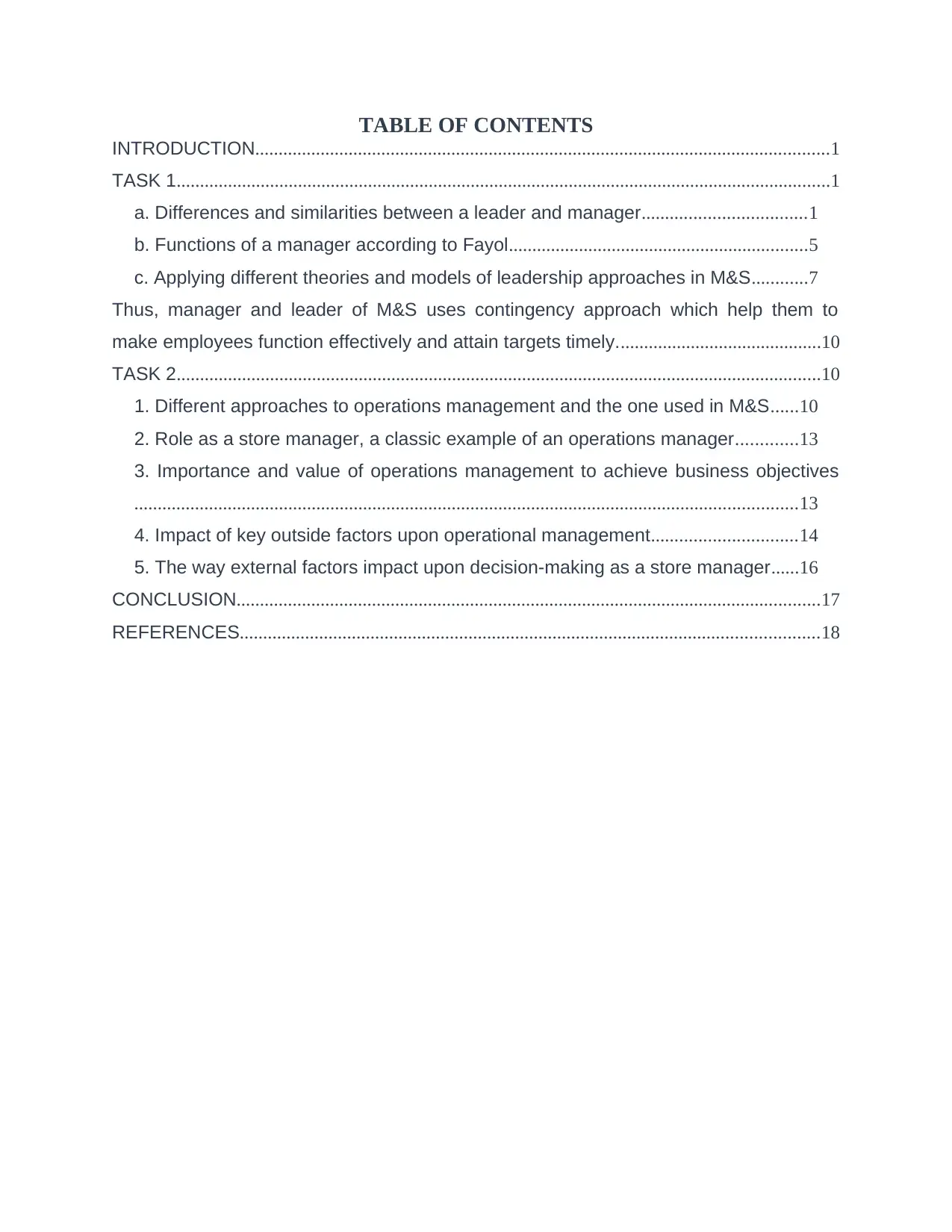
TABLE OF CONTENTS
INTRODUCTION...........................................................................................................................1
TASK 1............................................................................................................................................1
a. Differences and similarities between a leader and manager...................................1
b. Functions of a manager according to Fayol................................................................5
c. Applying different theories and models of leadership approaches in M&S............7
Thus, manager and leader of M&S uses contingency approach which help them to
make employees function effectively and attain targets timely............................................10
TASK 2..........................................................................................................................................10
1. Different approaches to operations management and the one used in M&S......10
2. Role as a store manager, a classic example of an operations manager.............13
3. Importance and value of operations management to achieve business objectives
..............................................................................................................................................13
4. Impact of key outside factors upon operational management...............................14
5. The way external factors impact upon decision-making as a store manager......16
CONCLUSION.............................................................................................................................17
REFERENCES............................................................................................................................18
INTRODUCTION...........................................................................................................................1
TASK 1............................................................................................................................................1
a. Differences and similarities between a leader and manager...................................1
b. Functions of a manager according to Fayol................................................................5
c. Applying different theories and models of leadership approaches in M&S............7
Thus, manager and leader of M&S uses contingency approach which help them to
make employees function effectively and attain targets timely............................................10
TASK 2..........................................................................................................................................10
1. Different approaches to operations management and the one used in M&S......10
2. Role as a store manager, a classic example of an operations manager.............13
3. Importance and value of operations management to achieve business objectives
..............................................................................................................................................13
4. Impact of key outside factors upon operational management...............................14
5. The way external factors impact upon decision-making as a store manager......16
CONCLUSION.............................................................................................................................17
REFERENCES............................................................................................................................18
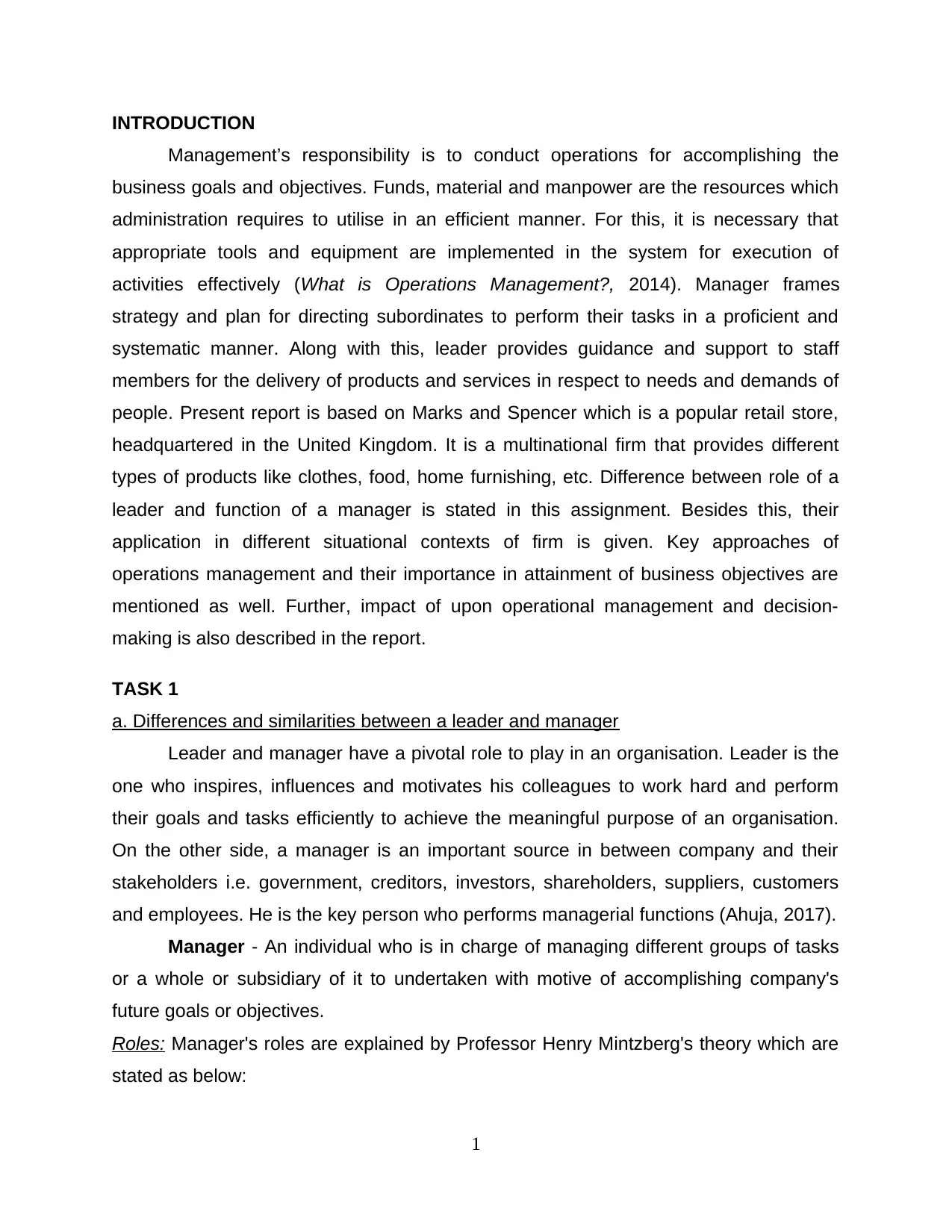
INTRODUCTION
Management’s responsibility is to conduct operations for accomplishing the
business goals and objectives. Funds, material and manpower are the resources which
administration requires to utilise in an efficient manner. For this, it is necessary that
appropriate tools and equipment are implemented in the system for execution of
activities effectively (What is Operations Management?, 2014). Manager frames
strategy and plan for directing subordinates to perform their tasks in a proficient and
systematic manner. Along with this, leader provides guidance and support to staff
members for the delivery of products and services in respect to needs and demands of
people. Present report is based on Marks and Spencer which is a popular retail store,
headquartered in the United Kingdom. It is a multinational firm that provides different
types of products like clothes, food, home furnishing, etc. Difference between role of a
leader and function of a manager is stated in this assignment. Besides this, their
application in different situational contexts of firm is given. Key approaches of
operations management and their importance in attainment of business objectives are
mentioned as well. Further, impact of upon operational management and decision-
making is also described in the report.
TASK 1
a. Differences and similarities between a leader and manager
Leader and manager have a pivotal role to play in an organisation. Leader is the
one who inspires, influences and motivates his colleagues to work hard and perform
their goals and tasks efficiently to achieve the meaningful purpose of an organisation.
On the other side, a manager is an important source in between company and their
stakeholders i.e. government, creditors, investors, shareholders, suppliers, customers
and employees. He is the key person who performs managerial functions (Ahuja, 2017).
Manager - An individual who is in charge of managing different groups of tasks
or a whole or subsidiary of it to undertaken with motive of accomplishing company's
future goals or objectives.
Roles: Manager's roles are explained by Professor Henry Mintzberg's theory which are
stated as below:
1
Management’s responsibility is to conduct operations for accomplishing the
business goals and objectives. Funds, material and manpower are the resources which
administration requires to utilise in an efficient manner. For this, it is necessary that
appropriate tools and equipment are implemented in the system for execution of
activities effectively (What is Operations Management?, 2014). Manager frames
strategy and plan for directing subordinates to perform their tasks in a proficient and
systematic manner. Along with this, leader provides guidance and support to staff
members for the delivery of products and services in respect to needs and demands of
people. Present report is based on Marks and Spencer which is a popular retail store,
headquartered in the United Kingdom. It is a multinational firm that provides different
types of products like clothes, food, home furnishing, etc. Difference between role of a
leader and function of a manager is stated in this assignment. Besides this, their
application in different situational contexts of firm is given. Key approaches of
operations management and their importance in attainment of business objectives are
mentioned as well. Further, impact of upon operational management and decision-
making is also described in the report.
TASK 1
a. Differences and similarities between a leader and manager
Leader and manager have a pivotal role to play in an organisation. Leader is the
one who inspires, influences and motivates his colleagues to work hard and perform
their goals and tasks efficiently to achieve the meaningful purpose of an organisation.
On the other side, a manager is an important source in between company and their
stakeholders i.e. government, creditors, investors, shareholders, suppliers, customers
and employees. He is the key person who performs managerial functions (Ahuja, 2017).
Manager - An individual who is in charge of managing different groups of tasks
or a whole or subsidiary of it to undertaken with motive of accomplishing company's
future goals or objectives.
Roles: Manager's roles are explained by Professor Henry Mintzberg's theory which are
stated as below:
1
⊘ This is a preview!⊘
Do you want full access?
Subscribe today to unlock all pages.

Trusted by 1+ million students worldwide
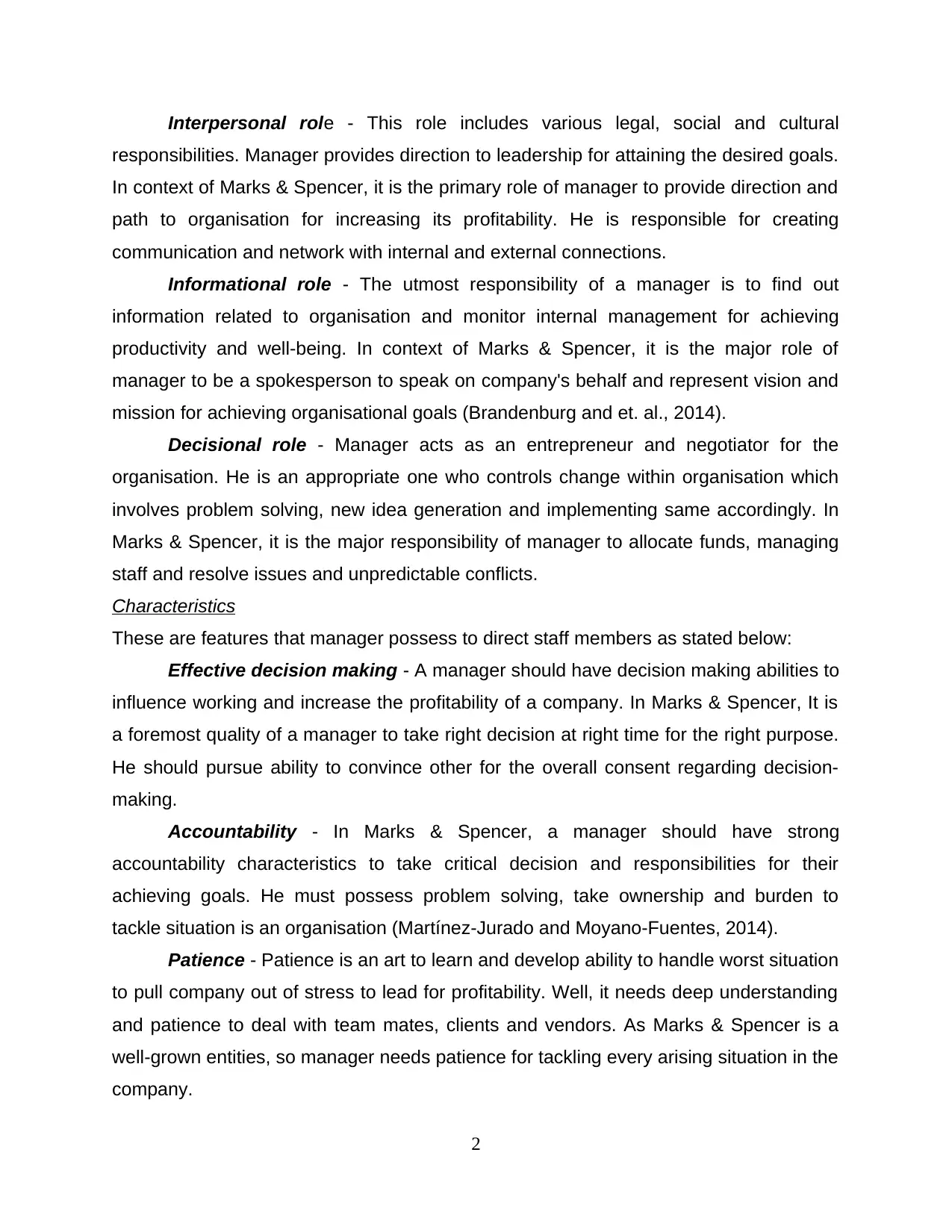
Interpersonal role - This role includes various legal, social and cultural
responsibilities. Manager provides direction to leadership for attaining the desired goals.
In context of Marks & Spencer, it is the primary role of manager to provide direction and
path to organisation for increasing its profitability. He is responsible for creating
communication and network with internal and external connections.
Informational role - The utmost responsibility of a manager is to find out
information related to organisation and monitor internal management for achieving
productivity and well-being. In context of Marks & Spencer, it is the major role of
manager to be a spokesperson to speak on company's behalf and represent vision and
mission for achieving organisational goals (Brandenburg and et. al., 2014).
Decisional role - Manager acts as an entrepreneur and negotiator for the
organisation. He is an appropriate one who controls change within organisation which
involves problem solving, new idea generation and implementing same accordingly. In
Marks & Spencer, it is the major responsibility of manager to allocate funds, managing
staff and resolve issues and unpredictable conflicts.
Characteristics
These are features that manager possess to direct staff members as stated below:
Effective decision making - A manager should have decision making abilities to
influence working and increase the profitability of a company. In Marks & Spencer, It is
a foremost quality of a manager to take right decision at right time for the right purpose.
He should pursue ability to convince other for the overall consent regarding decision-
making.
Accountability - In Marks & Spencer, a manager should have strong
accountability characteristics to take critical decision and responsibilities for their
achieving goals. He must possess problem solving, take ownership and burden to
tackle situation is an organisation (Martínez-Jurado and Moyano-Fuentes, 2014).
Patience - Patience is an art to learn and develop ability to handle worst situation
to pull company out of stress to lead for profitability. Well, it needs deep understanding
and patience to deal with team mates, clients and vendors. As Marks & Spencer is a
well-grown entities, so manager needs patience for tackling every arising situation in the
company.
2
responsibilities. Manager provides direction to leadership for attaining the desired goals.
In context of Marks & Spencer, it is the primary role of manager to provide direction and
path to organisation for increasing its profitability. He is responsible for creating
communication and network with internal and external connections.
Informational role - The utmost responsibility of a manager is to find out
information related to organisation and monitor internal management for achieving
productivity and well-being. In context of Marks & Spencer, it is the major role of
manager to be a spokesperson to speak on company's behalf and represent vision and
mission for achieving organisational goals (Brandenburg and et. al., 2014).
Decisional role - Manager acts as an entrepreneur and negotiator for the
organisation. He is an appropriate one who controls change within organisation which
involves problem solving, new idea generation and implementing same accordingly. In
Marks & Spencer, it is the major responsibility of manager to allocate funds, managing
staff and resolve issues and unpredictable conflicts.
Characteristics
These are features that manager possess to direct staff members as stated below:
Effective decision making - A manager should have decision making abilities to
influence working and increase the profitability of a company. In Marks & Spencer, It is
a foremost quality of a manager to take right decision at right time for the right purpose.
He should pursue ability to convince other for the overall consent regarding decision-
making.
Accountability - In Marks & Spencer, a manager should have strong
accountability characteristics to take critical decision and responsibilities for their
achieving goals. He must possess problem solving, take ownership and burden to
tackle situation is an organisation (Martínez-Jurado and Moyano-Fuentes, 2014).
Patience - Patience is an art to learn and develop ability to handle worst situation
to pull company out of stress to lead for profitability. Well, it needs deep understanding
and patience to deal with team mates, clients and vendors. As Marks & Spencer is a
well-grown entities, so manager needs patience for tackling every arising situation in the
company.
2
Paraphrase This Document
Need a fresh take? Get an instant paraphrase of this document with our AI Paraphraser
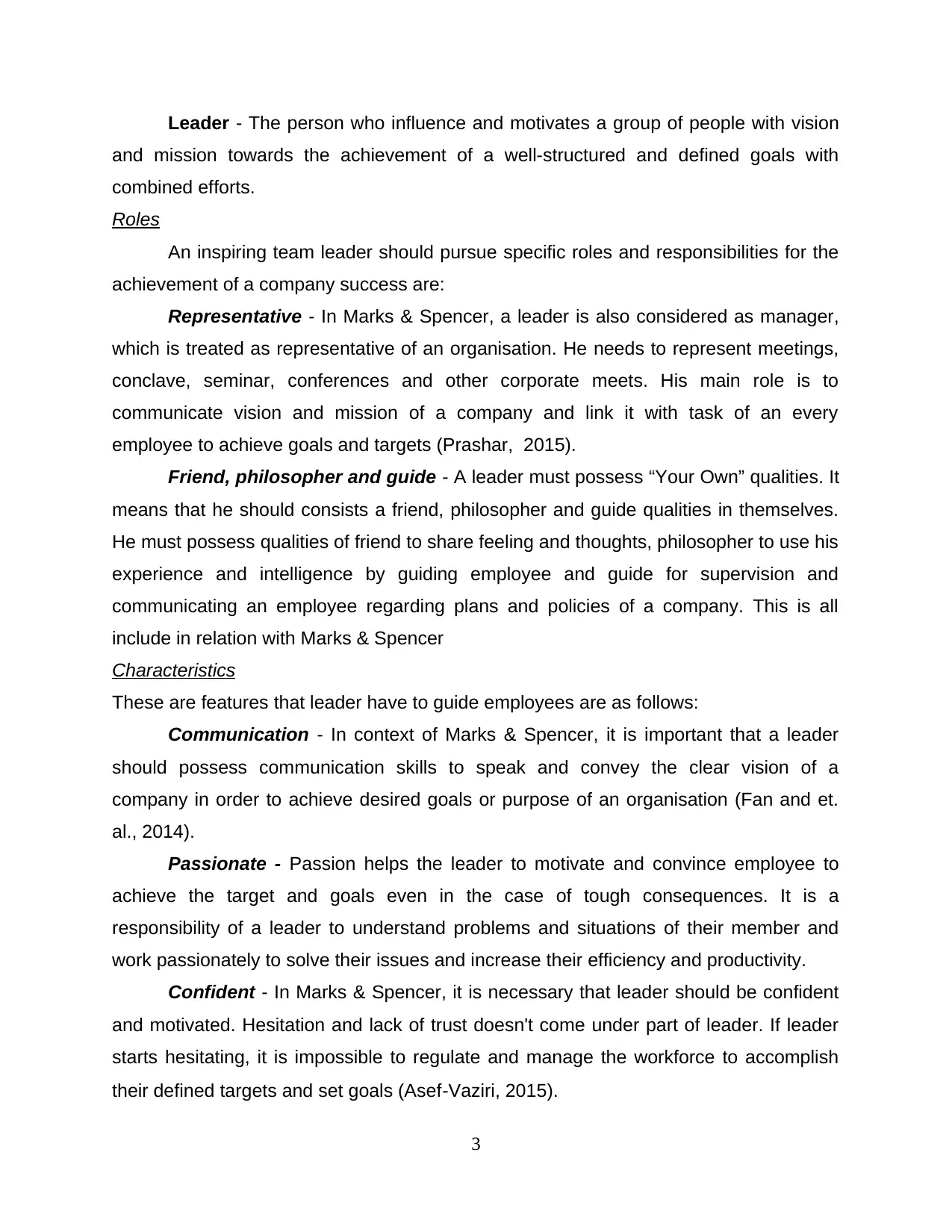
Leader - The person who influence and motivates a group of people with vision
and mission towards the achievement of a well-structured and defined goals with
combined efforts.
Roles
An inspiring team leader should pursue specific roles and responsibilities for the
achievement of a company success are:
Representative - In Marks & Spencer, a leader is also considered as manager,
which is treated as representative of an organisation. He needs to represent meetings,
conclave, seminar, conferences and other corporate meets. His main role is to
communicate vision and mission of a company and link it with task of an every
employee to achieve goals and targets (Prashar, 2015).
Friend, philosopher and guide - A leader must possess “Your Own” qualities. It
means that he should consists a friend, philosopher and guide qualities in themselves.
He must possess qualities of friend to share feeling and thoughts, philosopher to use his
experience and intelligence by guiding employee and guide for supervision and
communicating an employee regarding plans and policies of a company. This is all
include in relation with Marks & Spencer
Characteristics
These are features that leader have to guide employees are as follows:
Communication - In context of Marks & Spencer, it is important that a leader
should possess communication skills to speak and convey the clear vision of a
company in order to achieve desired goals or purpose of an organisation (Fan and et.
al., 2014).
Passionate - Passion helps the leader to motivate and convince employee to
achieve the target and goals even in the case of tough consequences. It is a
responsibility of a leader to understand problems and situations of their member and
work passionately to solve their issues and increase their efficiency and productivity.
Confident - In Marks & Spencer, it is necessary that leader should be confident
and motivated. Hesitation and lack of trust doesn't come under part of leader. If leader
starts hesitating, it is impossible to regulate and manage the workforce to accomplish
their defined targets and set goals (Asef‐Vaziri, 2015).
3
and mission towards the achievement of a well-structured and defined goals with
combined efforts.
Roles
An inspiring team leader should pursue specific roles and responsibilities for the
achievement of a company success are:
Representative - In Marks & Spencer, a leader is also considered as manager,
which is treated as representative of an organisation. He needs to represent meetings,
conclave, seminar, conferences and other corporate meets. His main role is to
communicate vision and mission of a company and link it with task of an every
employee to achieve goals and targets (Prashar, 2015).
Friend, philosopher and guide - A leader must possess “Your Own” qualities. It
means that he should consists a friend, philosopher and guide qualities in themselves.
He must possess qualities of friend to share feeling and thoughts, philosopher to use his
experience and intelligence by guiding employee and guide for supervision and
communicating an employee regarding plans and policies of a company. This is all
include in relation with Marks & Spencer
Characteristics
These are features that leader have to guide employees are as follows:
Communication - In context of Marks & Spencer, it is important that a leader
should possess communication skills to speak and convey the clear vision of a
company in order to achieve desired goals or purpose of an organisation (Fan and et.
al., 2014).
Passionate - Passion helps the leader to motivate and convince employee to
achieve the target and goals even in the case of tough consequences. It is a
responsibility of a leader to understand problems and situations of their member and
work passionately to solve their issues and increase their efficiency and productivity.
Confident - In Marks & Spencer, it is necessary that leader should be confident
and motivated. Hesitation and lack of trust doesn't come under part of leader. If leader
starts hesitating, it is impossible to regulate and manage the workforce to accomplish
their defined targets and set goals (Asef‐Vaziri, 2015).
3
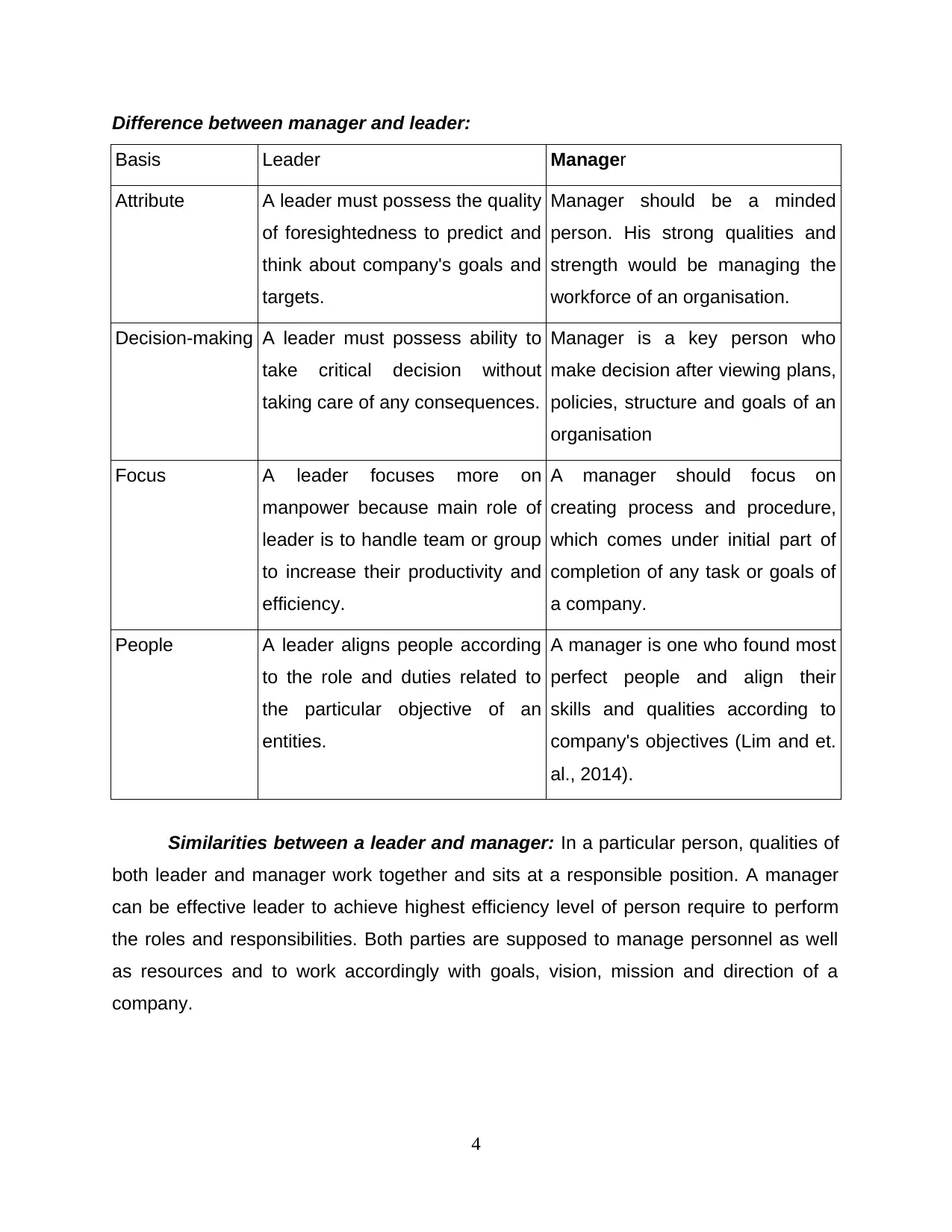
Difference between manager and leader:
Basis Leader Manager
Attribute A leader must possess the quality
of foresightedness to predict and
think about company's goals and
targets.
Manager should be a minded
person. His strong qualities and
strength would be managing the
workforce of an organisation.
Decision-making A leader must possess ability to
take critical decision without
taking care of any consequences.
Manager is a key person who
make decision after viewing plans,
policies, structure and goals of an
organisation
Focus A leader focuses more on
manpower because main role of
leader is to handle team or group
to increase their productivity and
efficiency.
A manager should focus on
creating process and procedure,
which comes under initial part of
completion of any task or goals of
a company.
People A leader aligns people according
to the role and duties related to
the particular objective of an
entities.
A manager is one who found most
perfect people and align their
skills and qualities according to
company's objectives (Lim and et.
al., 2014).
Similarities between a leader and manager: In a particular person, qualities of
both leader and manager work together and sits at a responsible position. A manager
can be effective leader to achieve highest efficiency level of person require to perform
the roles and responsibilities. Both parties are supposed to manage personnel as well
as resources and to work accordingly with goals, vision, mission and direction of a
company.
4
Basis Leader Manager
Attribute A leader must possess the quality
of foresightedness to predict and
think about company's goals and
targets.
Manager should be a minded
person. His strong qualities and
strength would be managing the
workforce of an organisation.
Decision-making A leader must possess ability to
take critical decision without
taking care of any consequences.
Manager is a key person who
make decision after viewing plans,
policies, structure and goals of an
organisation
Focus A leader focuses more on
manpower because main role of
leader is to handle team or group
to increase their productivity and
efficiency.
A manager should focus on
creating process and procedure,
which comes under initial part of
completion of any task or goals of
a company.
People A leader aligns people according
to the role and duties related to
the particular objective of an
entities.
A manager is one who found most
perfect people and align their
skills and qualities according to
company's objectives (Lim and et.
al., 2014).
Similarities between a leader and manager: In a particular person, qualities of
both leader and manager work together and sits at a responsible position. A manager
can be effective leader to achieve highest efficiency level of person require to perform
the roles and responsibilities. Both parties are supposed to manage personnel as well
as resources and to work accordingly with goals, vision, mission and direction of a
company.
4
⊘ This is a preview!⊘
Do you want full access?
Subscribe today to unlock all pages.

Trusted by 1+ million students worldwide
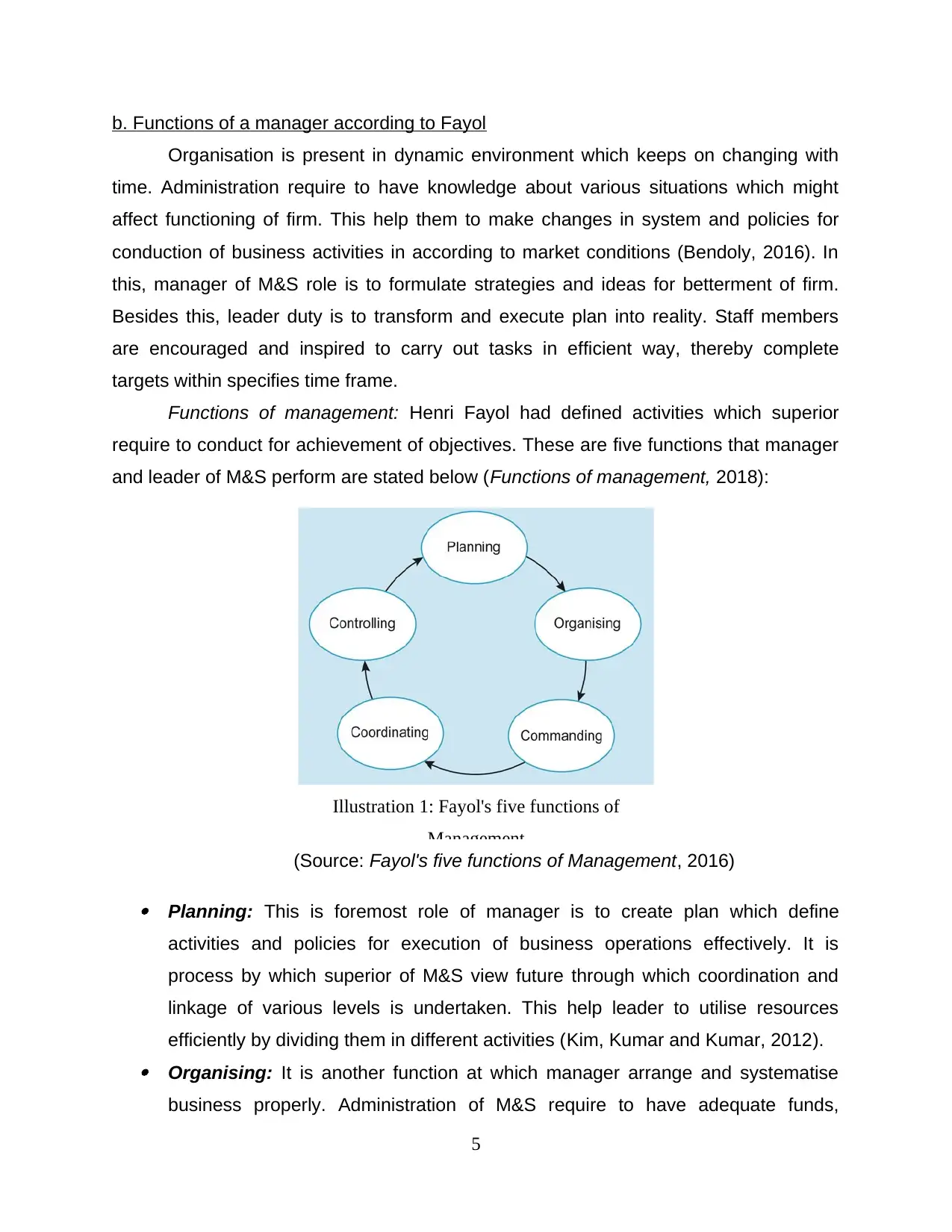
b. Functions of a manager according to Fayol
Organisation is present in dynamic environment which keeps on changing with
time. Administration require to have knowledge about various situations which might
affect functioning of firm. This help them to make changes in system and policies for
conduction of business activities in according to market conditions (Bendoly, 2016). In
this, manager of M&S role is to formulate strategies and ideas for betterment of firm.
Besides this, leader duty is to transform and execute plan into reality. Staff members
are encouraged and inspired to carry out tasks in efficient way, thereby complete
targets within specifies time frame.
Functions of management: Henri Fayol had defined activities which superior
require to conduct for achievement of objectives. These are five functions that manager
and leader of M&S perform are stated below (Functions of management, 2018):
(Source: Fayol's five functions of Management, 2016)
Planning: This is foremost role of manager is to create plan which define
activities and policies for execution of business operations effectively. It is
process by which superior of M&S view future through which coordination and
linkage of various levels is undertaken. This help leader to utilise resources
efficiently by dividing them in different activities (Kim, Kumar and Kumar, 2012). Organising: It is another function at which manager arrange and systematise
business properly. Administration of M&S require to have adequate funds,
5
Illustration 1: Fayol's five functions of
Management
Organisation is present in dynamic environment which keeps on changing with
time. Administration require to have knowledge about various situations which might
affect functioning of firm. This help them to make changes in system and policies for
conduction of business activities in according to market conditions (Bendoly, 2016). In
this, manager of M&S role is to formulate strategies and ideas for betterment of firm.
Besides this, leader duty is to transform and execute plan into reality. Staff members
are encouraged and inspired to carry out tasks in efficient way, thereby complete
targets within specifies time frame.
Functions of management: Henri Fayol had defined activities which superior
require to conduct for achievement of objectives. These are five functions that manager
and leader of M&S perform are stated below (Functions of management, 2018):
(Source: Fayol's five functions of Management, 2016)
Planning: This is foremost role of manager is to create plan which define
activities and policies for execution of business operations effectively. It is
process by which superior of M&S view future through which coordination and
linkage of various levels is undertaken. This help leader to utilise resources
efficiently by dividing them in different activities (Kim, Kumar and Kumar, 2012). Organising: It is another function at which manager arrange and systematise
business properly. Administration of M&S require to have adequate funds,
5
Illustration 1: Fayol's five functions of
Management
Paraphrase This Document
Need a fresh take? Get an instant paraphrase of this document with our AI Paraphraser
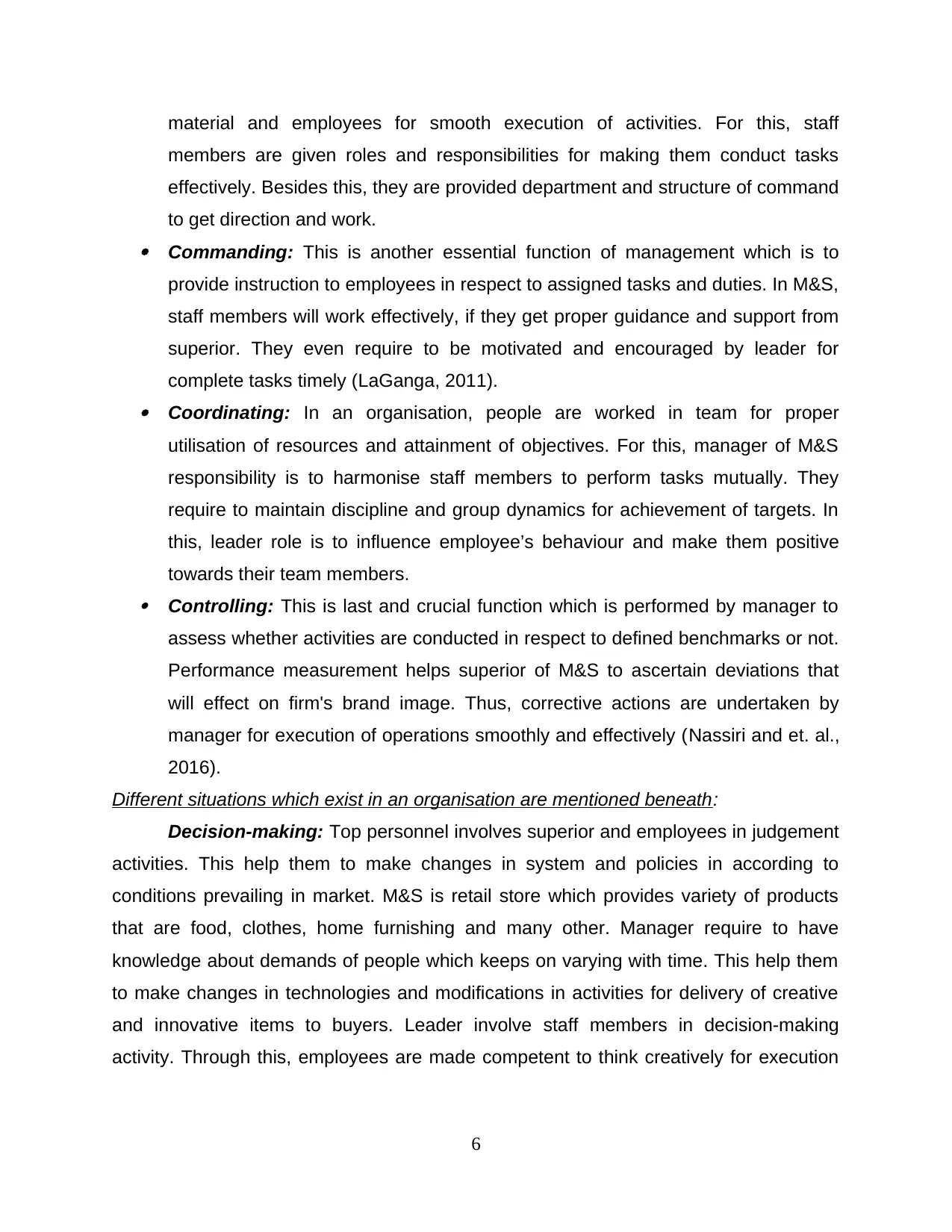
material and employees for smooth execution of activities. For this, staff
members are given roles and responsibilities for making them conduct tasks
effectively. Besides this, they are provided department and structure of command
to get direction and work. Commanding: This is another essential function of management which is to
provide instruction to employees in respect to assigned tasks and duties. In M&S,
staff members will work effectively, if they get proper guidance and support from
superior. They even require to be motivated and encouraged by leader for
complete tasks timely (LaGanga, 2011). Coordinating: In an organisation, people are worked in team for proper
utilisation of resources and attainment of objectives. For this, manager of M&S
responsibility is to harmonise staff members to perform tasks mutually. They
require to maintain discipline and group dynamics for achievement of targets. In
this, leader role is to influence employee’s behaviour and make them positive
towards their team members. Controlling: This is last and crucial function which is performed by manager to
assess whether activities are conducted in respect to defined benchmarks or not.
Performance measurement helps superior of M&S to ascertain deviations that
will effect on firm's brand image. Thus, corrective actions are undertaken by
manager for execution of operations smoothly and effectively (Nassiri and et. al.,
2016).
Different situations which exist in an organisation are mentioned beneath:
Decision-making: Top personnel involves superior and employees in judgement
activities. This help them to make changes in system and policies in according to
conditions prevailing in market. M&S is retail store which provides variety of products
that are food, clothes, home furnishing and many other. Manager require to have
knowledge about demands of people which keeps on varying with time. This help them
to make changes in technologies and modifications in activities for delivery of creative
and innovative items to buyers. Leader involve staff members in decision-making
activity. Through this, employees are made competent to think creatively for execution
6
members are given roles and responsibilities for making them conduct tasks
effectively. Besides this, they are provided department and structure of command
to get direction and work. Commanding: This is another essential function of management which is to
provide instruction to employees in respect to assigned tasks and duties. In M&S,
staff members will work effectively, if they get proper guidance and support from
superior. They even require to be motivated and encouraged by leader for
complete tasks timely (LaGanga, 2011). Coordinating: In an organisation, people are worked in team for proper
utilisation of resources and attainment of objectives. For this, manager of M&S
responsibility is to harmonise staff members to perform tasks mutually. They
require to maintain discipline and group dynamics for achievement of targets. In
this, leader role is to influence employee’s behaviour and make them positive
towards their team members. Controlling: This is last and crucial function which is performed by manager to
assess whether activities are conducted in respect to defined benchmarks or not.
Performance measurement helps superior of M&S to ascertain deviations that
will effect on firm's brand image. Thus, corrective actions are undertaken by
manager for execution of operations smoothly and effectively (Nassiri and et. al.,
2016).
Different situations which exist in an organisation are mentioned beneath:
Decision-making: Top personnel involves superior and employees in judgement
activities. This help them to make changes in system and policies in according to
conditions prevailing in market. M&S is retail store which provides variety of products
that are food, clothes, home furnishing and many other. Manager require to have
knowledge about demands of people which keeps on varying with time. This help them
to make changes in technologies and modifications in activities for delivery of creative
and innovative items to buyers. Leader involve staff members in decision-making
activity. Through this, employees are made competent to think creatively for execution
6
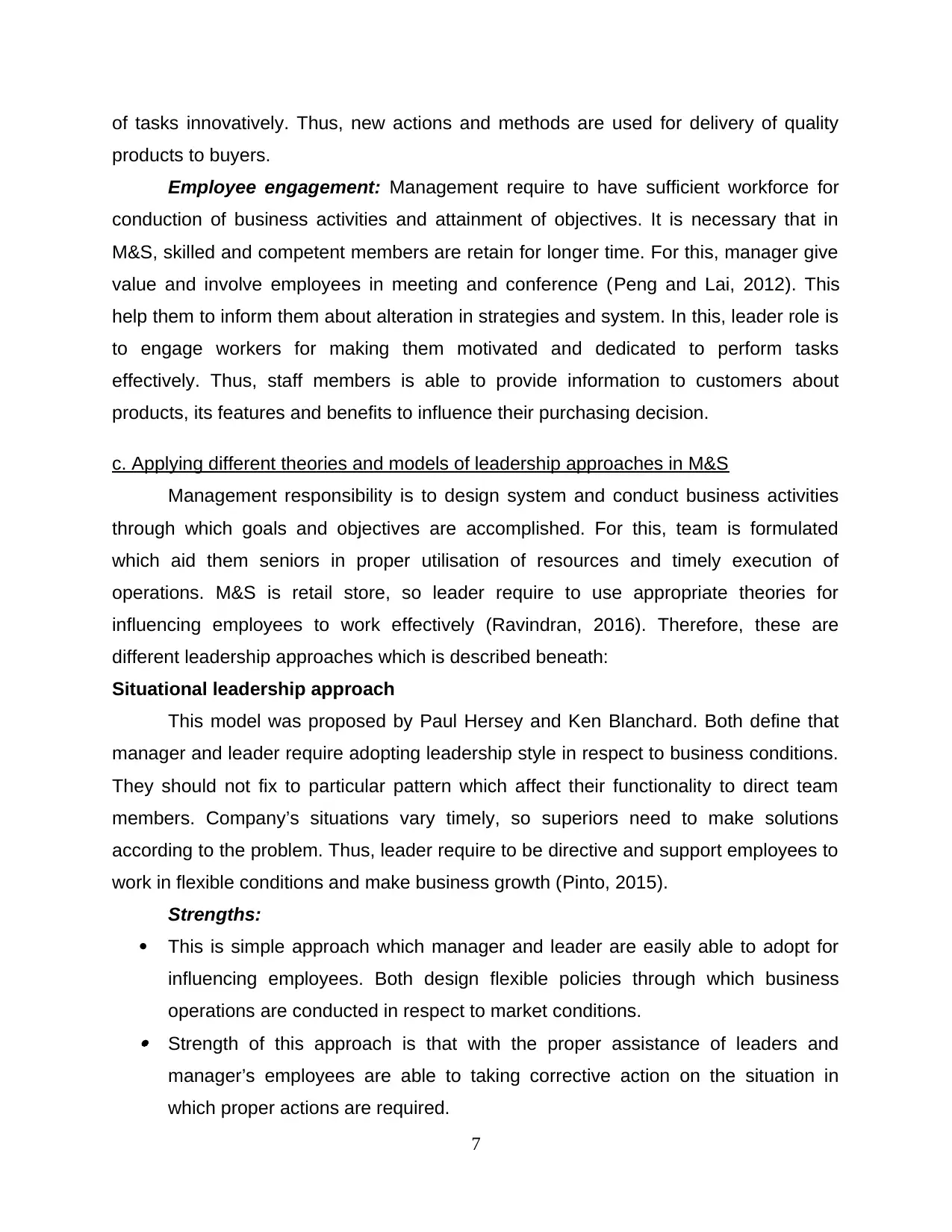
of tasks innovatively. Thus, new actions and methods are used for delivery of quality
products to buyers.
Employee engagement: Management require to have sufficient workforce for
conduction of business activities and attainment of objectives. It is necessary that in
M&S, skilled and competent members are retain for longer time. For this, manager give
value and involve employees in meeting and conference (Peng and Lai, 2012). This
help them to inform them about alteration in strategies and system. In this, leader role is
to engage workers for making them motivated and dedicated to perform tasks
effectively. Thus, staff members is able to provide information to customers about
products, its features and benefits to influence their purchasing decision.
c. Applying different theories and models of leadership approaches in M&S
Management responsibility is to design system and conduct business activities
through which goals and objectives are accomplished. For this, team is formulated
which aid them seniors in proper utilisation of resources and timely execution of
operations. M&S is retail store, so leader require to use appropriate theories for
influencing employees to work effectively (Ravindran, 2016). Therefore, these are
different leadership approaches which is described beneath:
Situational leadership approach
This model was proposed by Paul Hersey and Ken Blanchard. Both define that
manager and leader require adopting leadership style in respect to business conditions.
They should not fix to particular pattern which affect their functionality to direct team
members. Company’s situations vary timely, so superiors need to make solutions
according to the problem. Thus, leader require to be directive and support employees to
work in flexible conditions and make business growth (Pinto, 2015).
Strengths:
This is simple approach which manager and leader are easily able to adopt for
influencing employees. Both design flexible policies through which business
operations are conducted in respect to market conditions. Strength of this approach is that with the proper assistance of leaders and
manager’s employees are able to taking corrective action on the situation in
which proper actions are required.
7
products to buyers.
Employee engagement: Management require to have sufficient workforce for
conduction of business activities and attainment of objectives. It is necessary that in
M&S, skilled and competent members are retain for longer time. For this, manager give
value and involve employees in meeting and conference (Peng and Lai, 2012). This
help them to inform them about alteration in strategies and system. In this, leader role is
to engage workers for making them motivated and dedicated to perform tasks
effectively. Thus, staff members is able to provide information to customers about
products, its features and benefits to influence their purchasing decision.
c. Applying different theories and models of leadership approaches in M&S
Management responsibility is to design system and conduct business activities
through which goals and objectives are accomplished. For this, team is formulated
which aid them seniors in proper utilisation of resources and timely execution of
operations. M&S is retail store, so leader require to use appropriate theories for
influencing employees to work effectively (Ravindran, 2016). Therefore, these are
different leadership approaches which is described beneath:
Situational leadership approach
This model was proposed by Paul Hersey and Ken Blanchard. Both define that
manager and leader require adopting leadership style in respect to business conditions.
They should not fix to particular pattern which affect their functionality to direct team
members. Company’s situations vary timely, so superiors need to make solutions
according to the problem. Thus, leader require to be directive and support employees to
work in flexible conditions and make business growth (Pinto, 2015).
Strengths:
This is simple approach which manager and leader are easily able to adopt for
influencing employees. Both design flexible policies through which business
operations are conducted in respect to market conditions. Strength of this approach is that with the proper assistance of leaders and
manager’s employees are able to taking corrective action on the situation in
which proper actions are required.
7
⊘ This is a preview!⊘
Do you want full access?
Subscribe today to unlock all pages.

Trusted by 1+ million students worldwide
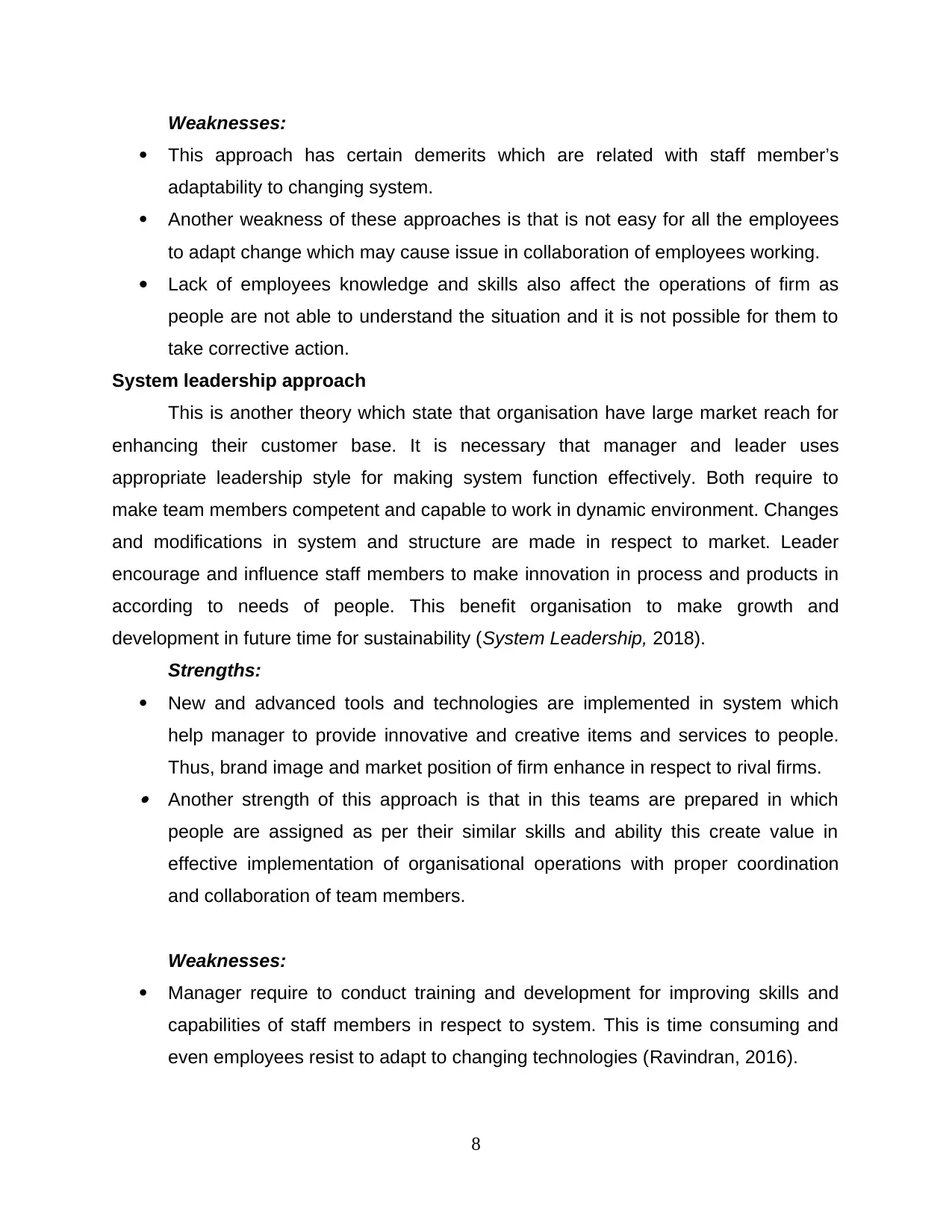
Weaknesses:
This approach has certain demerits which are related with staff member’s
adaptability to changing system.
Another weakness of these approaches is that is not easy for all the employees
to adapt change which may cause issue in collaboration of employees working.
Lack of employees knowledge and skills also affect the operations of firm as
people are not able to understand the situation and it is not possible for them to
take corrective action.
System leadership approach
This is another theory which state that organisation have large market reach for
enhancing their customer base. It is necessary that manager and leader uses
appropriate leadership style for making system function effectively. Both require to
make team members competent and capable to work in dynamic environment. Changes
and modifications in system and structure are made in respect to market. Leader
encourage and influence staff members to make innovation in process and products in
according to needs of people. This benefit organisation to make growth and
development in future time for sustainability (System Leadership, 2018).
Strengths:
New and advanced tools and technologies are implemented in system which
help manager to provide innovative and creative items and services to people.
Thus, brand image and market position of firm enhance in respect to rival firms. Another strength of this approach is that in this teams are prepared in which
people are assigned as per their similar skills and ability this create value in
effective implementation of organisational operations with proper coordination
and collaboration of team members.
Weaknesses:
Manager require to conduct training and development for improving skills and
capabilities of staff members in respect to system. This is time consuming and
even employees resist to adapt to changing technologies (Ravindran, 2016).
8
This approach has certain demerits which are related with staff member’s
adaptability to changing system.
Another weakness of these approaches is that is not easy for all the employees
to adapt change which may cause issue in collaboration of employees working.
Lack of employees knowledge and skills also affect the operations of firm as
people are not able to understand the situation and it is not possible for them to
take corrective action.
System leadership approach
This is another theory which state that organisation have large market reach for
enhancing their customer base. It is necessary that manager and leader uses
appropriate leadership style for making system function effectively. Both require to
make team members competent and capable to work in dynamic environment. Changes
and modifications in system and structure are made in respect to market. Leader
encourage and influence staff members to make innovation in process and products in
according to needs of people. This benefit organisation to make growth and
development in future time for sustainability (System Leadership, 2018).
Strengths:
New and advanced tools and technologies are implemented in system which
help manager to provide innovative and creative items and services to people.
Thus, brand image and market position of firm enhance in respect to rival firms. Another strength of this approach is that in this teams are prepared in which
people are assigned as per their similar skills and ability this create value in
effective implementation of organisational operations with proper coordination
and collaboration of team members.
Weaknesses:
Manager require to conduct training and development for improving skills and
capabilities of staff members in respect to system. This is time consuming and
even employees resist to adapt to changing technologies (Ravindran, 2016).
8
Paraphrase This Document
Need a fresh take? Get an instant paraphrase of this document with our AI Paraphraser
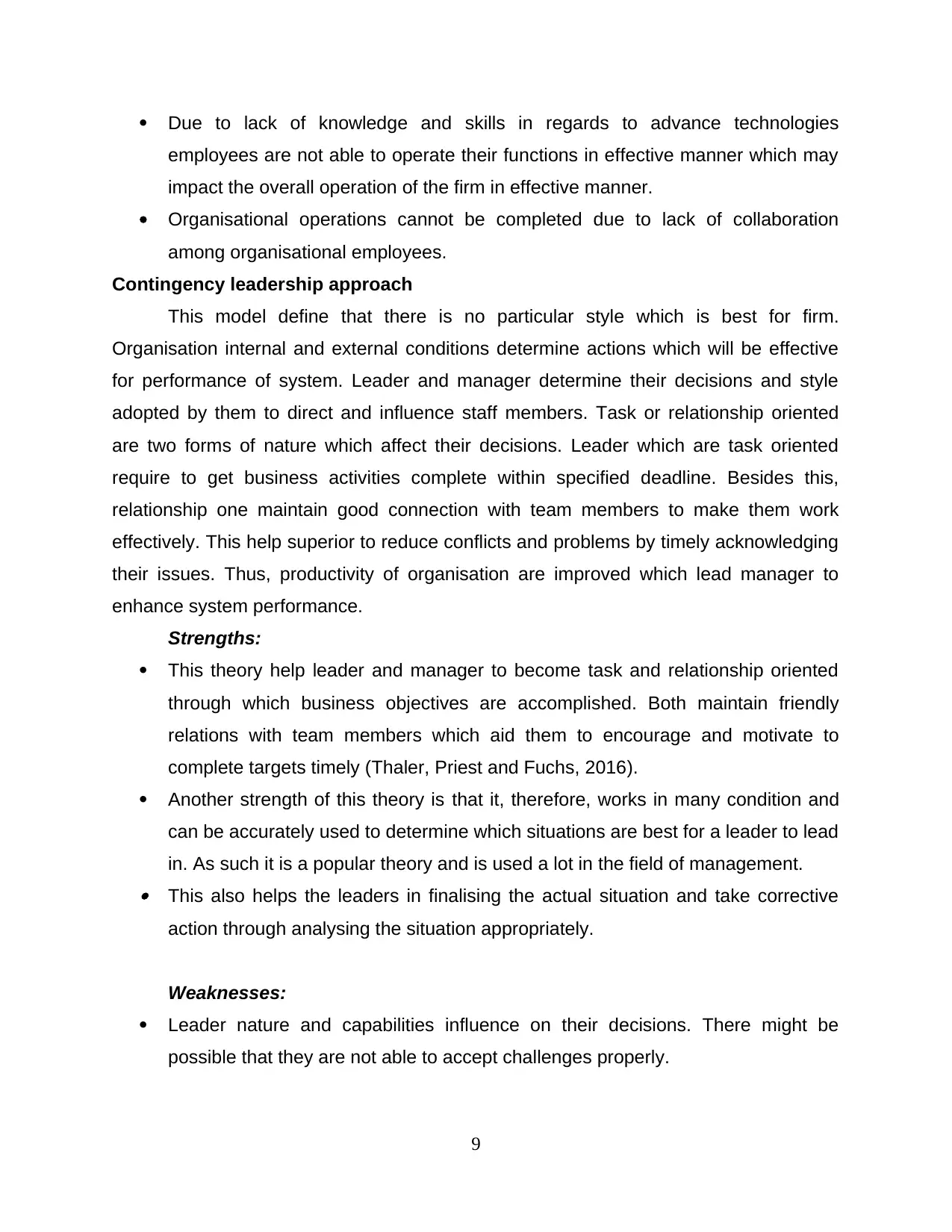
Due to lack of knowledge and skills in regards to advance technologies
employees are not able to operate their functions in effective manner which may
impact the overall operation of the firm in effective manner.
Organisational operations cannot be completed due to lack of collaboration
among organisational employees.
Contingency leadership approach
This model define that there is no particular style which is best for firm.
Organisation internal and external conditions determine actions which will be effective
for performance of system. Leader and manager determine their decisions and style
adopted by them to direct and influence staff members. Task or relationship oriented
are two forms of nature which affect their decisions. Leader which are task oriented
require to get business activities complete within specified deadline. Besides this,
relationship one maintain good connection with team members to make them work
effectively. This help superior to reduce conflicts and problems by timely acknowledging
their issues. Thus, productivity of organisation are improved which lead manager to
enhance system performance.
Strengths:
This theory help leader and manager to become task and relationship oriented
through which business objectives are accomplished. Both maintain friendly
relations with team members which aid them to encourage and motivate to
complete targets timely (Thaler, Priest and Fuchs, 2016).
Another strength of this theory is that it, therefore, works in many condition and
can be accurately used to determine which situations are best for a leader to lead
in. As such it is a popular theory and is used a lot in the field of management. This also helps the leaders in finalising the actual situation and take corrective
action through analysing the situation appropriately.
Weaknesses:
Leader nature and capabilities influence on their decisions. There might be
possible that they are not able to accept challenges properly.
9
employees are not able to operate their functions in effective manner which may
impact the overall operation of the firm in effective manner.
Organisational operations cannot be completed due to lack of collaboration
among organisational employees.
Contingency leadership approach
This model define that there is no particular style which is best for firm.
Organisation internal and external conditions determine actions which will be effective
for performance of system. Leader and manager determine their decisions and style
adopted by them to direct and influence staff members. Task or relationship oriented
are two forms of nature which affect their decisions. Leader which are task oriented
require to get business activities complete within specified deadline. Besides this,
relationship one maintain good connection with team members to make them work
effectively. This help superior to reduce conflicts and problems by timely acknowledging
their issues. Thus, productivity of organisation are improved which lead manager to
enhance system performance.
Strengths:
This theory help leader and manager to become task and relationship oriented
through which business objectives are accomplished. Both maintain friendly
relations with team members which aid them to encourage and motivate to
complete targets timely (Thaler, Priest and Fuchs, 2016).
Another strength of this theory is that it, therefore, works in many condition and
can be accurately used to determine which situations are best for a leader to lead
in. As such it is a popular theory and is used a lot in the field of management. This also helps the leaders in finalising the actual situation and take corrective
action through analysing the situation appropriately.
Weaknesses:
Leader nature and capabilities influence on their decisions. There might be
possible that they are not able to accept challenges properly.
9
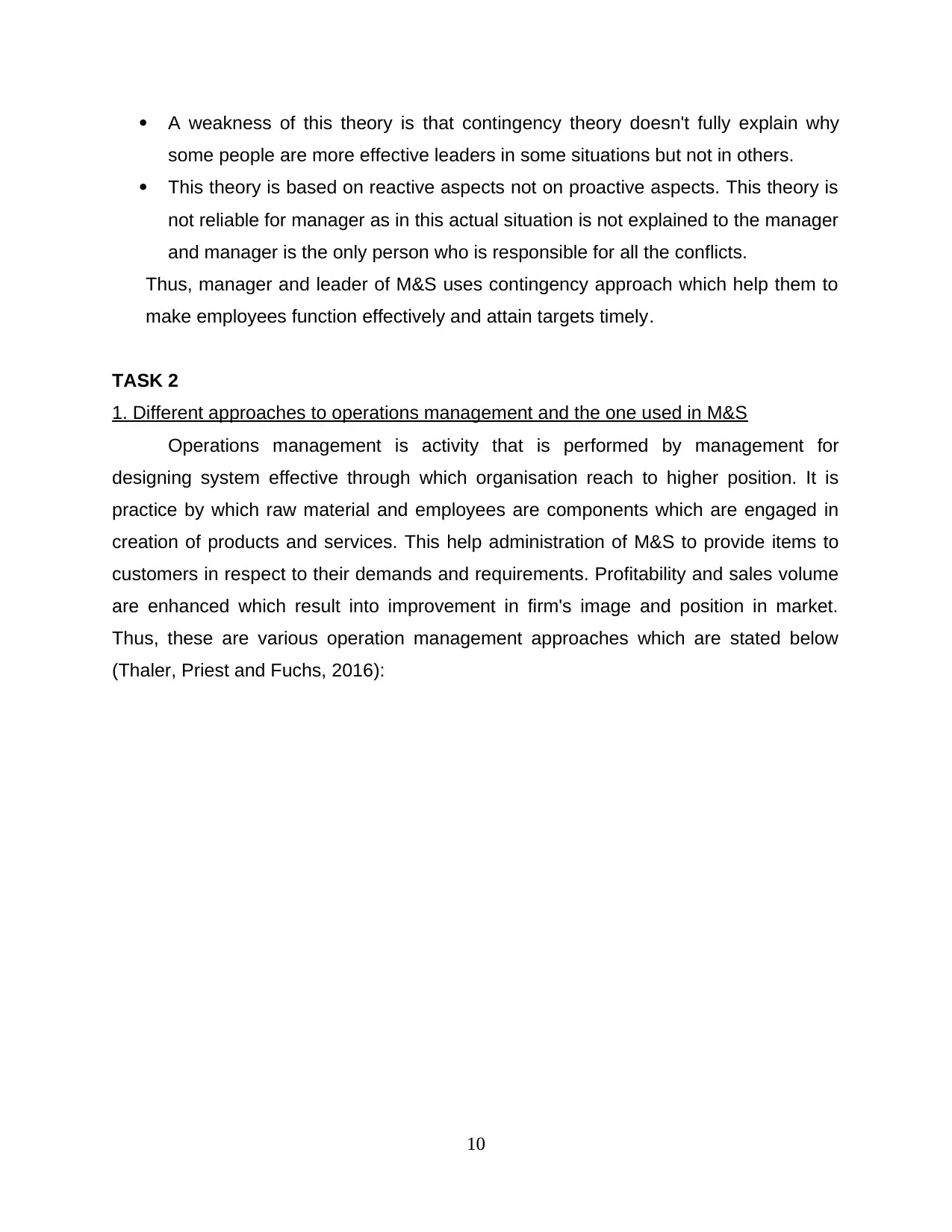
A weakness of this theory is that contingency theory doesn't fully explain why
some people are more effective leaders in some situations but not in others.
This theory is based on reactive aspects not on proactive aspects. This theory is
not reliable for manager as in this actual situation is not explained to the manager
and manager is the only person who is responsible for all the conflicts.
Thus, manager and leader of M&S uses contingency approach which help them to
make employees function effectively and attain targets timely.
TASK 2
1. Different approaches to operations management and the one used in M&S
Operations management is activity that is performed by management for
designing system effective through which organisation reach to higher position. It is
practice by which raw material and employees are components which are engaged in
creation of products and services. This help administration of M&S to provide items to
customers in respect to their demands and requirements. Profitability and sales volume
are enhanced which result into improvement in firm's image and position in market.
Thus, these are various operation management approaches which are stated below
(Thaler, Priest and Fuchs, 2016):
10
some people are more effective leaders in some situations but not in others.
This theory is based on reactive aspects not on proactive aspects. This theory is
not reliable for manager as in this actual situation is not explained to the manager
and manager is the only person who is responsible for all the conflicts.
Thus, manager and leader of M&S uses contingency approach which help them to
make employees function effectively and attain targets timely.
TASK 2
1. Different approaches to operations management and the one used in M&S
Operations management is activity that is performed by management for
designing system effective through which organisation reach to higher position. It is
practice by which raw material and employees are components which are engaged in
creation of products and services. This help administration of M&S to provide items to
customers in respect to their demands and requirements. Profitability and sales volume
are enhanced which result into improvement in firm's image and position in market.
Thus, these are various operation management approaches which are stated below
(Thaler, Priest and Fuchs, 2016):
10
⊘ This is a preview!⊘
Do you want full access?
Subscribe today to unlock all pages.

Trusted by 1+ million students worldwide
1 out of 23
Related Documents
Your All-in-One AI-Powered Toolkit for Academic Success.
+13062052269
info@desklib.com
Available 24*7 on WhatsApp / Email
![[object Object]](/_next/static/media/star-bottom.7253800d.svg)
Unlock your academic potential
Copyright © 2020–2025 A2Z Services. All Rights Reserved. Developed and managed by ZUCOL.





